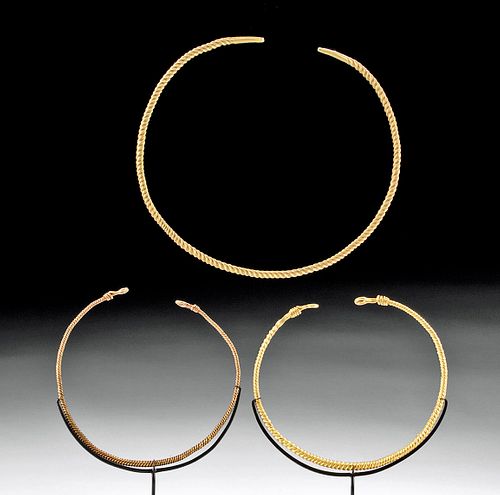Group of 3 Celtic 20K+ Gold Torqs - Art Loss Certs.
Lot 64b
About Seller
Artemis Fine Arts
686 S Taylor Ave, Ste 106
Louisville, CO 80027
United States
Selling antiquities, ancient and ethnographic art online since 1993, Artemis Gallery specializes in Classical Antiquities (Egyptian, Greek, Roman, Near Eastern), Asian, Pre-Columbian, African / Tribal / Oceanographic art. Our extensive inventory includes pottery, stone, metal, wood, glass and textil...Read more
Categories
Estimate:
$12,000 - $18,000
Absentee vs Live bid
Two ways to bid:
- Leave a max absentee bid and the platform will bid on your behalf up to your maximum bid during the live auction.
- Bid live during the auction and your bids will be submitted real-time to the auctioneer.
Bid Increments
| Price | Bid Increment |
|---|---|
| $0 | $25 |
| $300 | $50 |
| $1,000 | $100 |
| $2,000 | $250 |
| $5,000 | $500 |
| $10,000 | $1,000 |
| $20,000 | $2,500 |
| $50,000 | $5,000 |
| $100,000 | $10,000 |
| $200,000 | $20,000 |
About Auction
By Artemis Fine Arts
Feb 13, 2020
Set Reminder
2020-02-13 10:00:00
2020-02-13 10:00:00
America/New_York
Bidsquare
Bidsquare : Exceptional Antiquities, Asian, Ethnographic
https://www.bidsquare.com/auctions/artemis-gallery/exceptional-antiquities-asian-ethnographic-4848
An important one-day auction featuring museum-worthy examples of Egyptian, Greek, Roman, Etruscan, Near Eastern, Far East / Asian, Pre-Columbian, African / Tribal, Oceanic, Native American, Spanish Colonial, Russian, Fossils, Ancient Jewelry, Fine Art, so much more! Artemis Fine Arts info@artemisfinearts.com
An important one-day auction featuring museum-worthy examples of Egyptian, Greek, Roman, Etruscan, Near Eastern, Far East / Asian, Pre-Columbian, African / Tribal, Oceanic, Native American, Spanish Colonial, Russian, Fossils, Ancient Jewelry, Fine Art, so much more! Artemis Fine Arts info@artemisfinearts.com
- Lot Description
Central to Northwestern Europe, Celtic, Iron Age, ca. first millennium BCE. Three elegant twisted gold Celtic torqs (also spelled torc or torque) - one of the smaller torqs comprised of 23K+ gold (96% gold); the second torq of similar size comprised of 20K+ gold (90% gold); the largest comprised of 20K+ gold (90% gold). Three striking gold torqs, examples of Celtic luxury art, replete with high quality gold and beautiful design. Each torc takes a simple shape – a nearly completed circle – and elaborates upon it to create a mesmerizing form. In keeping with their name (from the Latin torquere – 'to twist'), torqs are fashioned from a single piece of twisted gold. The resulting multiple ridges and furrows beautifully reflect light cast upon their surface. Weight: 272.2 grams. Gold Quality: one of the smaller torqs -96% gold, equivalent to 23K+; torq of similar size - 90% gold, equivalent to 20K+; largest 90% gold, equivalent to 20K+ Size: largest 6.375" L x 7.5" W (16.2 cm x 19 cm); smallest ~ 4.875" diameter (12.4 cm); 5.5" H (14 cm) on included custom stand.
Gold torqs represent one of the most intricate and iconic forms of Celtic art. These exquisite examples demonstrate the ancient artists' reverence for exceptional workmanship and precious materials. Torqs were worn as powerful status symbols, and revered for their affinities with the divine, and as symbols of might and strength, especially in the context of war.
The Celts, a mixture of the Indo-European peoples who spoke a language akin to Latin, originated circa 1200 BCC in the basin of the upper Danube, the Alps, eastern France, and southern Germany. During the Archaic and Classical Greek periods, from the ninth to fourth centuries BCE, Celtic culture predominated in transalpine Europe, and the Celts gradually came to inhabit most of Europe, from the Black Sea in the east to the British Isles in the west. Greek authors of the sixth century BCE wrote of a people called the keltoi in southern France and, a century later, Herodotus located their homelands in the region around the Danube. In time, their settlements stretched from Turkey and the Balkans across to Western Europe. At the peak of their power, they were strong enough to sack Rome (386 BCE) and Delphi (279 BCE). The legacy of these victories was soon eclipsed, however, by the rise of the Roman empire in the Italian peninsula. Here, the historical lack of cohesion between the various Celtic tribes proved to be their downfall. One by one, they were overrun or expelled from their homelands. By the beginning of the Christian era, they were pushed back to the western fringes of the continent, in the north of England, Ireland, Wales and Breton France (modern Brittany).
Accompanied by Art Loss Register (ref: S00119900) dated 22 December 2016, signed by Julian Radcliffe.
Provenance: ex Morris Pinto Collection, early 1980s; accompanied by Art Loss Register (ref: S00119900) dated 22 December 2016, signed by Julian Radcliffe
All items legal to buy/sell under U.S. Statute covering cultural patrimony Code 2600, CHAPTER 14, and are guaranteed to be as described or your money back.
A Certificate of Authenticity will accompany all winning bids.
We ship worldwide and handle all shipping in-house for your convenience.
#152762All are in excellent condition, and the gold has developed a warm patina. The two smaller resolve in looped terminals. The larger one in pointed terminals. The smaller pair come with display stands.Condition
- Shipping Info
-
All shipping is handled in-house for your convenience. Your invoice from Artemis Gallery will include shipping calculation instructions. If in doubt, please inquire BEFORE bidding for estimated shipping costs for individual items.
-
- Buyer's Premium



 EUR
EUR CAD
CAD AUD
AUD GBP
GBP MXN
MXN HKD
HKD CNY
CNY MYR
MYR SEK
SEK SGD
SGD CHF
CHF THB
THB















